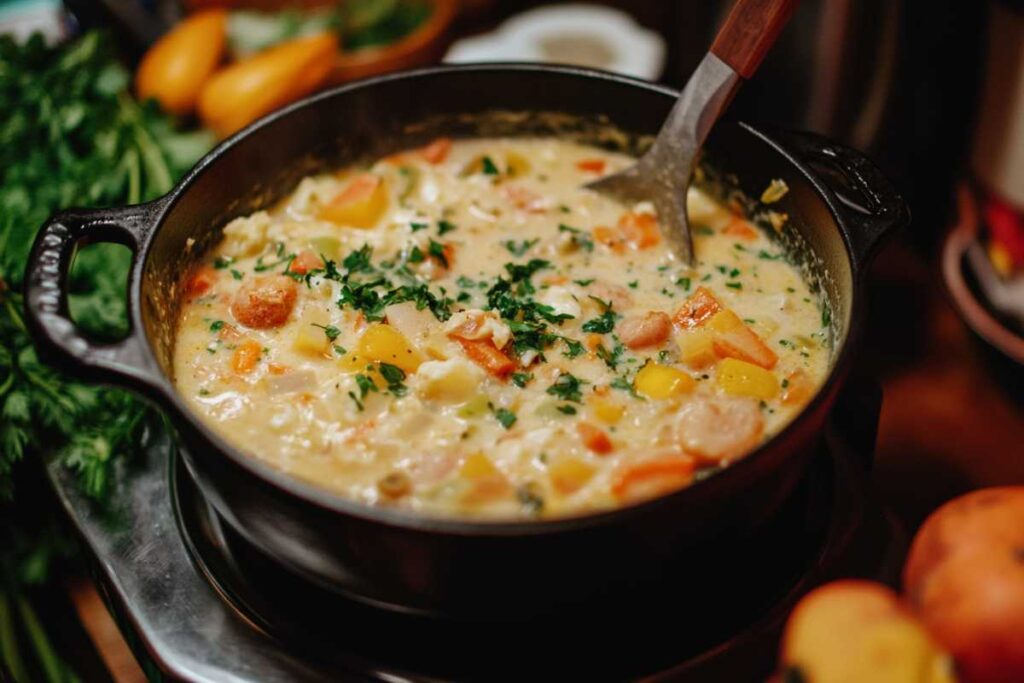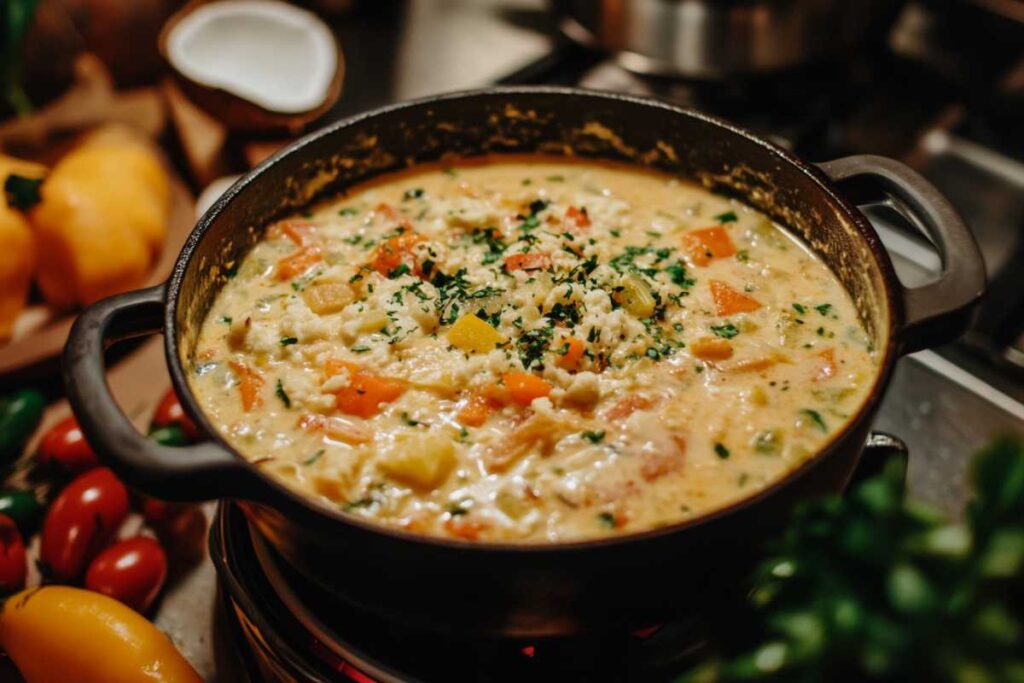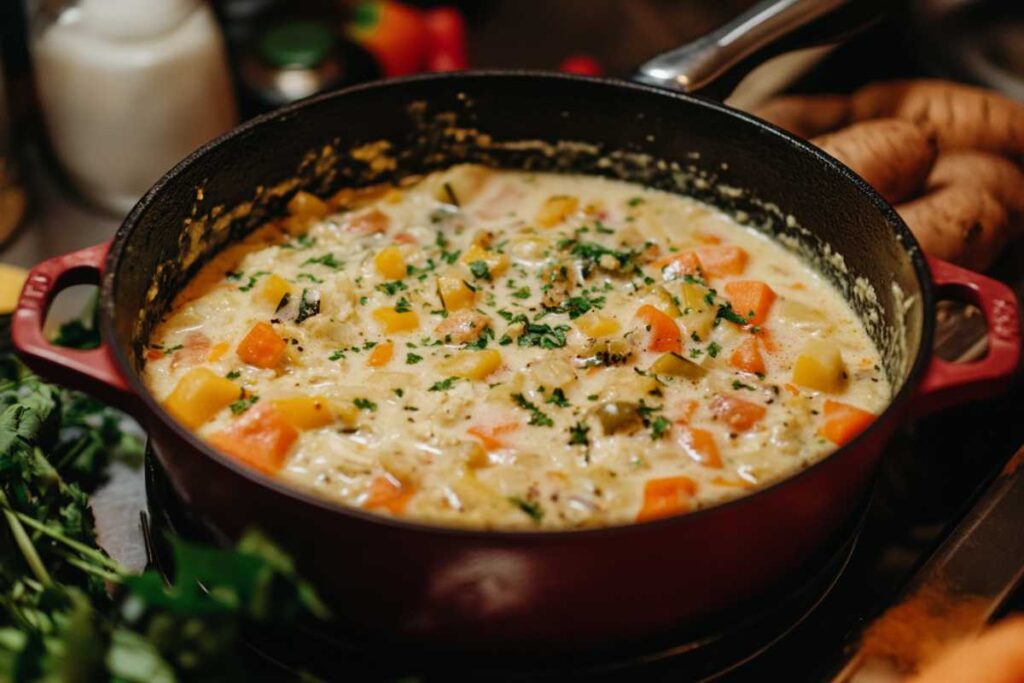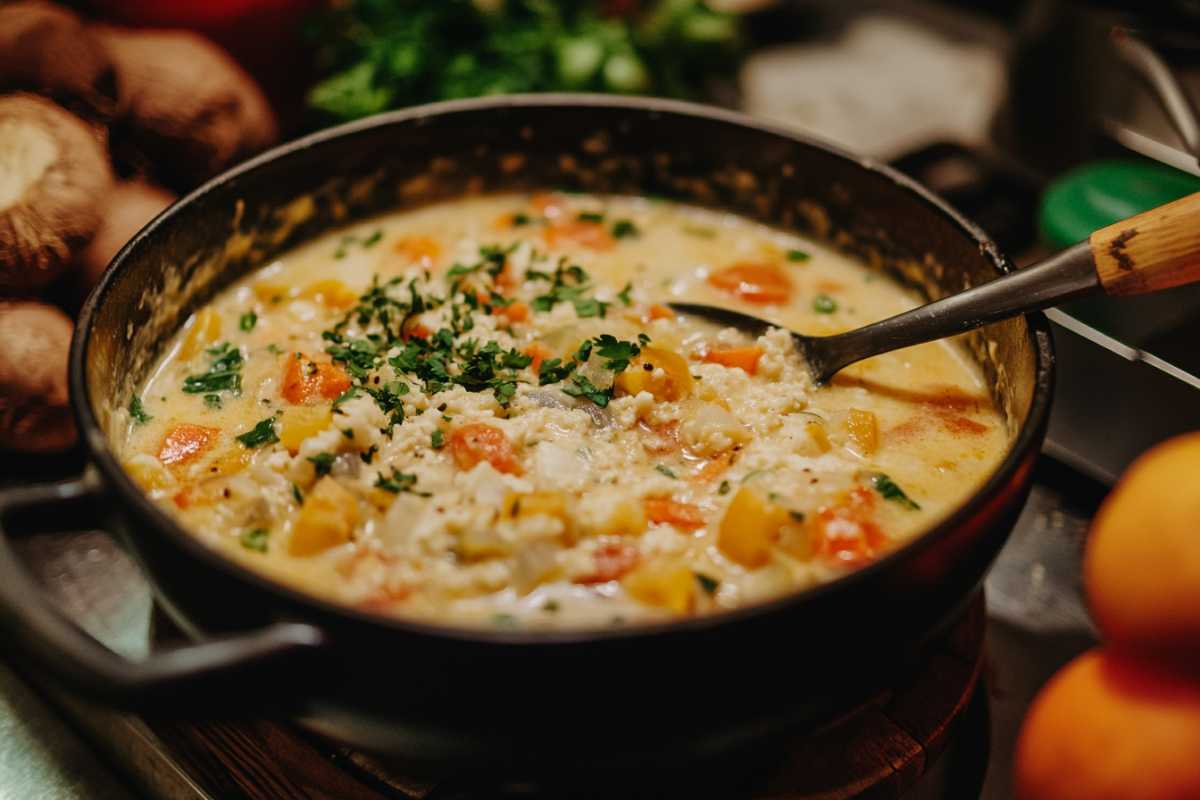Caribbean soups are known for their bold flavors, rich textures, and comforting qualities, making them a staple in the region’s cuisine. From hearty pepper pot to creamy seafood soups, achieving the perfect consistency is essential to creating an authentic dish. But how to thicken Caribbean soup effectively? This question often arises for both novice and experienced cooks who want to master the art of creating thick, satisfying broths.
Understanding the right techniques and ingredients is crucial to elevating the texture and flavor of these iconic dishes. Whether you’re using traditional methods like root vegetables and plantains or exploring modern approaches with roux or coconut milk, there are countless ways to perfect your soup’s consistency. In this guide, we’ll explore proven methods, practical tips, and cultural insights to help you master how to thicken Caribbean soup and create bowls of deliciousness that capture the heart of the Caribbean.
The Foundation of Thick Caribbean Soups
The Importance of Thickness in Caribbean Soups
Caribbean soups are celebrated for their hearty, rich flavors and satisfying textures. A defining characteristic of these soups is their thick consistency, which not only enhances the eating experience but also allows the bold flavors of the Caribbean to shine. From classic Jamaican pumpkin soup to Trinidadian corn soup, achieving the right thickness is key to capturing the essence of these dishes.
Thick soups are more than a culinary preference; they are a cultural hallmark that symbolizes abundance and nourishment. If you’re new to Caribbean cooking, you might find inspiration in the way local ingredients come together, as seen in dishes like Jamaican Soup, which balances textures and flavors beautifully.
Challenges in Achieving Perfect Thickness
Creating the perfect Caribbean soup consistency can sometimes be tricky. Common issues include:
- Thin or watery textures: These often occur when the ratio of liquid to solid ingredients is too high.
- Uneven consistency: This happens when thickening agents aren’t properly integrated.
- Over-thickening: While thickness is important, it’s equally essential to maintain balance for a smooth, enjoyable texture.
Learning how to troubleshoot and avoid these pitfalls will make your soups more consistent and delicious. For example, much like balancing the components in a Hotcake Mix Recipe, achieving a well-thickened soup requires attention to detail and a good understanding of ingredient behavior.
Traditional Methods to Thicken Caribbean Soup
Root Vegetables as Natural Thickeners
One of the most traditional methods for thickening Caribbean soups is using root vegetables like:
- Yams
- Sweet potatoes
- Cassava
These starchy ingredients are boiled until soft, then either mashed or blended into the soup. The starches they release naturally thicken the broth, adding both body and flavor. This method is a cornerstone of Caribbean cooking, as seen in hearty dishes like Trinidadian callaloo.
Plantains and Breadfruit
Another classic thickening method involves adding green plantains or breadfruit, which are staples in Caribbean cuisine. These ingredients:
- Are grated or mashed before being incorporated into the soup.
- Release starches during cooking to create a creamy consistency.
- Contribute unique flavors that complement the spices and herbs commonly used in Caribbean recipes.
For another dish that showcases the versatility of tropical ingredients, consider the use of plantains in recipes like Garlic Parmesan Chicken and Potatoes, which also emphasizes balancing texture and flavor.
Modern Approaches to Thickening Soups
While traditional methods hold timeless appeal, modern techniques can also be employed to thicken Caribbean soups more efficiently:
- Making a Roux: A combination of fat (like butter) and flour cooked together creates a roux, which can be whisked into the soup for a creamy, smooth texture.
- Using Cornstarch or Arrowroot Slurry: Mixing these starches with cold water creates a quick-thickening slurry that’s easy to incorporate without lumps.
- Pureeing Ingredients: Blending a portion of the soup allows you to thicken it naturally without additional ingredients.
For a deeper dive into making roux or exploring other thickening bases, take a look at Creme Brulee Vs Custard, which explains similar principles in desserts.
Practical Tips for Achieving Perfect Thickness
- Control Your Liquid: Start with less liquid than the recipe calls for; you can always add more later to adjust the consistency.
- Simmer for Longer: Allowing the soup to simmer uncovered helps reduce excess liquid naturally, concentrating the flavors and thickening the broth.
- Blend Gradually: Pureeing small portions of the soup ensures you don’t over-thicken it, maintaining the ideal texture.
The Cultural Connection
In Caribbean cuisine, the thickness of a soup is more than just a texture—it’s a reflection of the region’s rich culinary traditions. Each ingredient, whether it’s a root vegetable or a tropical fruit, contributes not only to the soup’s consistency but also to its unique cultural identity. By mastering these techniques, you can create soups that are as rich in flavor as they are in heritage.
Thickening soups is not only about improving the texture but also about enhancing the overall experience of the dish. Whether you’re recreating a traditional Caribbean soup or experimenting with your own variation, remember that the right balance of ingredients is key. For more inspiration, explore classic recipes like the vibrant Jamaican Soup to see how Caribbean chefs perfect their craft.
Techniques and Ingredients: How to Thicken Caribbean Soup

Traditional Ingredients for Thickening Caribbean Soup
Using Root Vegetables
One of the most trusted methods for thickening Caribbean soup is the use of root vegetables. These starchy ingredients naturally dissolve into the broth, creating a creamy and rich texture. The most common root vegetables used include:
- Yams: A versatile ingredient that adds subtle sweetness.
- Sweet Potatoes: Perfect for soups that need a touch of creaminess.
- Cassava: Adds a hearty, earthy flavor to traditional Caribbean dishes.
These vegetables can be boiled, mashed, or pureed to achieve the desired consistency. Their starch content ensures the soup remains thick without needing artificial additives. For more on balancing textures with similar ingredients, check out how they are utilized in the Garlic Parmesan Chicken and Potatoes recipe.
Incorporating Plantains and Breadfruit
Another cornerstone of Caribbean soups is the inclusion of green plantains and breadfruit. These tropical staples provide a dual benefit:
- Thickening: Grating or mashing them releases starches into the soup, ensuring a velvety texture.
- Flavoring: Their unique flavors complement the bold spices and herbs commonly used in Caribbean cuisine.
These ingredients are especially prominent in dishes like Jamaican pepper pot soup, where their creaminess balances the spices. For another example of creative ingredient use, visit Jamaican Soup, which showcases how traditional ingredients contribute to texture and flavor.
Modern Methods for Thickening Caribbean Soup

Making a Roux
A roux—a combination of flour and fat cooked together—is a classic method for thickening soups. It’s a go-to technique in many kitchens because of its simplicity and effectiveness. To make a roux for Caribbean soup:
- Melt butter or heat oil in a pan.
- Stir in an equal amount of flour.
- Cook until golden brown, then whisk it into your soup.
This technique not only thickens the soup but also adds a nutty flavor that complements rich Caribbean spices. If you’re curious about similar cooking principles, explore Creme Brulee Vs Custard for insights into balancing textures in recipes.
Using Cornstarch or Arrowroot Slurry
For a quick and efficient thickening solution, cornstarch or arrowroot powder can be used. These methods are particularly useful when you need to maintain a soup’s clarity or finish:
- Mix 1 tablespoon of cornstarch or arrowroot powder with 2 tablespoons of cold water.
- Stir the slurry into the soup, allowing it to thicken as it heats.
Arrowroot is often preferred for Caribbean soups because it doesn’t alter the flavor or cloud the broth, making it ideal for lighter soups like fish tea or callaloo.
Thickening with Coconut Milk or Cream
Coconut milk is a quintessential ingredient in many Caribbean soups, offering both flavor and texture. Its high fat content adds richness while naturally thickening the broth. This method is particularly popular in soups featuring:
- Seafood: The creaminess pairs well with shrimp, fish, and crab.
- Curry Flavors: Enhances the spice profile without overpowering it.
To achieve the best results, use full-fat coconut milk. For another dish where coconut milk shines, explore the recipe for Vegan Vietnamese Sweet Soup.
Practical Tips for Perfectly Thickened Caribbean Soups

Simmering for Reduction
One of the simplest methods to thicken soup is by simmering it uncovered. This allows excess liquid to evaporate, concentrating the flavors and thickening the broth. The key steps include:
- Start with high heat to bring the soup to a boil.
- Reduce the heat to a gentle simmer.
- Stir occasionally to prevent sticking.
Pureeing Ingredients
Blending part of the soup is an easy and effective way to thicken without adding extra ingredients:
- Use an immersion blender to puree directly in the pot.
- Alternatively, transfer a portion of the soup to a blender, then return it to the pot.
This technique works well for soups with starchy vegetables or legumes.
Balancing Flavors and Textures
While thickening your Caribbean soup, it’s crucial to ensure the thickening agents don’t overpower the flavors. Keep these tips in mind:
- Adjust seasoning after thickening, as the concentrated broth might intensify the saltiness or spice.
- Avoid over-thickening; the soup should still have a smooth and pourable consistency.
For additional guidance on maintaining balance in recipes, explore tips from the Hotcake Mix Recipe.
Common Mistakes to Avoid
- Adding Thickening Agents Too Early: Ingredients like flour or cornstarch should be added towards the end to prevent over-thickening.
- Not Stirring Properly: Ensure all thickening agents are evenly distributed to avoid clumps.
- Overcooking Starches: Prolonged cooking can break down starches, leading to a gummy texture.
A Cultural Connection
Learning how to thicken Caribbean soup is more than a culinary skill—it’s a way to honor the rich traditions of Caribbean cooking. From using native ingredients like yams and breadfruit to incorporating modern techniques like roux and cornstarch, each method reflects the region’s creativity and resourcefulness. By mastering these techniques, you can elevate your soups to a level of authenticity and flavor that pays homage to the vibrant culture of the Caribbean.
FAQs on How to Thicken Caribbean Soup
How do I make my soup thicker?
Use starchy vegetables like yams, add coconut milk, or simmer uncovered to reduce liquid.
How to fix soup that is too watery?
Add a slurry of cornstarch or flour, puree vegetables, or simmer to evaporate excess water.
What do restaurants use to thicken soup?
Common methods include roux, pureeing ingredients, or adding cornstarch/arrowroot slurry.
Is it better to use flour or cornstarch to thicken soup?
Flour works for creamy soups; cornstarch provides a clear, glossy finish for lighter broths.
Conclusion: Mastering the Art of Thickening Caribbean Soups
Learning how to thicken Caribbean soup is a rewarding journey that connects you to the rich culinary traditions of the Caribbean. Whether you’re using traditional methods like yams and plantains or modern techniques like a roux or coconut milk, each approach adds its unique touch to the dish. By understanding the balance between flavor and texture, you can create soups that are both hearty and flavorful.
To dive deeper into Caribbean culinary techniques, explore the vibrant flavors in Jamaican Soup and the creative use of ingredients in Garlic Parmesan Chicken and Potatoes. These recipes highlight the importance of balance and creativity, essential skills for perfecting your thickened soups. With practice, you’ll not only master the texture but also bring the authentic essence of the Caribbean to your kitchen.

